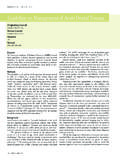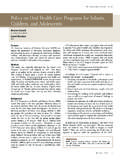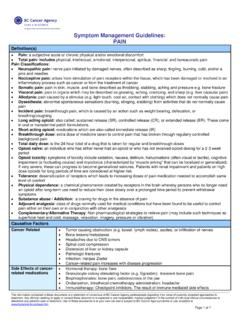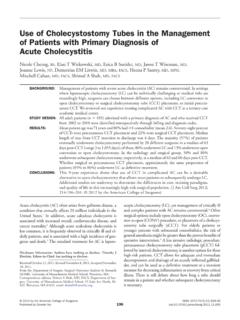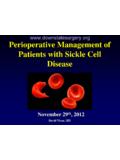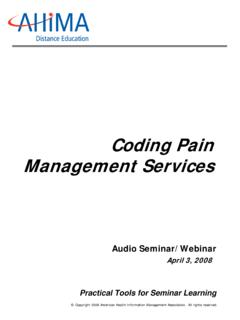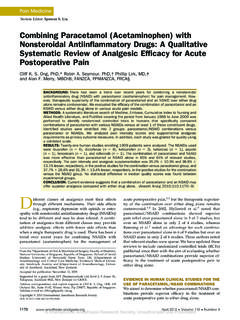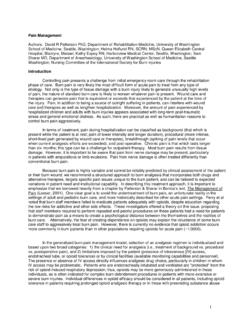Transcription of Policy on Acute Pediatric Dental Pain Management
1 AMERICAN ACADEMY OF Pediatric DENTISTRY. Policy on Acute Pediatric Dental pain Management Review Council Council on Clinical Affairs Latest Revision 2017. Purpose tioner must accurately reflect pain intensity. pain experienced The American Academy of Pediatric Dentistry (AAPD) recog- by children with special health care needs or developmental nizes that children vary greatly in their cognitive and emo- disabilities is more challenging to assess accurately and may tional development, medical conditions, and responses to pain require utilization of scales that rely on observations such as and interventions. Infants, children, adolescents, and those vocalization, facial expressions, and body with special health care needs can and do experience pain , and In addition to documenting pain severity, it is important the majority of pain in the Dental setting can be prevented or to assess pain onset, pattern, location, and quality; aggravating substantially relieved.
2 The AAPD further recognizes that there and relieving factors; previous treatment and its effect; and are many therapeutics available to treat pain with varying barriers to When assessing pain in a child, the dosages and/or regimens. Recent concerns have developed patient's psychological status should be considered. The dentist about toxicities associated with codeine. also should account for the intensity and duration of pain that may be perceived from a given Dental ,8 pain man- Methods agement may range from non-pharmacologic modalities to This Policy was originally developed by the Council on Clini- pharmacological treatment. Nonpharmacologic therapy includes cal Affairs and adopted in 2012. This document is an update maintaining a calm environment, encouraging deep breathing, of the previous version and is based on a review of current and employing guided imagery, distraction, play therapy, and Dental and medical literature pertaining to Pediatric pain Pharmacologic therapy may consist of adminis- Management including a search with PubMed /MEDLINE.
3 Using the terms: Pediatric Dental pain Management , Pediatric tration of topical and local anesthesia, analgesic medications, and/or mild, moderate, or deep sedation ,10. pain Management , Pediatric postoperative pain Management , The extent of treatment affects post-operative pain . It has Pediatric analgesic overdose; fields: all; limits: within the last been reported that 95 percent of children undergoing full ten years, humans, all children zero to 18 years, English, clin- mouth Dental rehabilitation, regardless of extent of treatment, ical trials, and literature reviews. The search returned 3,388 report pain of moderate intensity. 8 pain scores usually are articles. The reviewers agreed upon the inclusion of 12 new highest immediately postoperatively while the patient is in the documents that met the defined criteria. Nine additional post-anesthesia recovery Due to analgesics and/or local documents were retained from the previous version of the anesthetics administered intra-operatively during Dental rehab- Policy for historical purposes.
4 When data did not appear ilitation, some patients may be delayed in their pain response sufficient or were inconclusive, information included in and report greater intensity of pain at home following the this police was based upon expert and/or consensus opinion procedures. Patients who had extractions, as well as those by experienced researchers and clinicians who had 12 or more Dental procedures, were more likely to experience pain at Background The selection of an appropriate analgesic depends on the pain assessment is an integral component of the Dental history individual patient, the extent of treatment, the duration of and comprehensive evaluation. When symptoms or signs of the procedure, psychological factors, and the patient's medical orofacial/ Dental pain are evident, a detailed pain assessment history. Physiologic factors such as bleeding disorders, liver should be conducted and documented in the patient's record.
5 Problems, and kidney problems should be given particular This assessment helps the dentist to derive a clinical diagnosis, attention since some analgesics may promote bleeding. 11 If develop a prioritized treatment plan, and better estimate anal- moderate to severe pain is considered likely, an analgesic gesic requirements for the patient. pain is difficult to measure due to its subjectivity, especially in children,1,2 and often relies on the report of parents. There ABBREVIATIONS. are several pain scale indicators that can be used with children, AAPD: American Academy Pediatric Dentistry. FDA: Food and Drug including the FACES pain scale and the Wong-Baker FACES Administration. NSAIDs: Nonsteroidal anti-inflammatory agents. ,2 The method of assessing pain selected by the practi- ORAL HE ALTH POLICIES 99. REFERENCE MANUAL V 39 / NO 6 17 / 18.
6 Should be administered on a regular schedule during the first codeine is not effectively broken down into the active meta- 36 to 48 hours to create stable plasma levels of analgesics and bolite Tests cleared by the Food and Drug decrease the chance of breakthrough ,12 Administration (FDA) are available and could be considered Treatment of postoperative pain may include opioid anal- to identify both ultra-rapid and poor metabolizers of codeine gesics and non-opioid analgesics. Since most cases of post- and other opioid Tramadol and, to a lesser extent, operative pain include an inflammatory component, nonsteroidal hydrocodone and oxycodone also are influenced by CYP2D6. anti-inflammatory agents (NSAIDs) are considered first line activity, and ultra-rapid metabolizers may have an increased agents in the treatment of Acute mild to moderate postoper- risk of In April, 2017, the FDA issued a warning to ative Aspirin-containing analgesics are contraindicated restrict the use of codeine and tramadol medicines in children for Pediatric pain Management in most situations because, if and breastfeeding Morphine and non-opioid alter- administered during a viral illness.
7 The potential exists for a natives are not influenced by CYP2D6 serious condition known as Reye Acetaminophen lacks anti-inflammatory properties but can be a non-opioid Policy statement alternative when NSAIDs are Acetaminophen The AAPD recognizes that children experience pain and ex- is found as a single agent and also in combination with other hibit variability in the expression of pain and that inadequate drugs. Overdose of acetaminophen is a potential Pediatric pain Management may have significant physical and psy- emergency, and the maximum daily dose should be observed, chological consequences for the patient. Therefore, the AAPD. especially when combination medications are Alternat- encourages health care professionals to: ing administration of ibuprofen and acetaminophen is another Recognize, assess, and document symptoms of pain strategy for pain Management in ,15 Acetaminophen in the patient's record.
8 Or NSAIDs also can be administered rectally or intravenously, Consider preoperative, intraoperative, and postoperative which may be practical in some settings ( , an operating pain Management options. room).13 Use non-pharmacologic and pharmacologic strategies Practitioners may be hesitant to prescribe opioid analgesics to reduce pain experience. for Pediatric patients for fear of addiction. Because opioid use Utilize drug formularies in order to accurately prescribe for Dental pain should be of short duration, physical depend- medications for the Management of pain . ence is unlikely and its use should be Opioid Choose agents compatible with the patient's medical analgesics are effective for moderate to severe postoperative history. pain , but have potential for adverse effects ( , nausea, emesis, Comprehend the consequences, morbidities, and toxi- constipation, sedation, respiratory depression) and cities associated with the use of specific therapeutics.
9 Parental anxiety about postoperative pain and potential adverse Consider non-opioid analgesics as first line agents for effects of pain medications may influence administration of pain Management . analgesics at ,7 Strategies that educate parents about Consider simultaneous use of analgesics with different anticipated postoperative discomfort and the benefits of pain mechanisms of action to optimize pain Management . medication have been associated with reduced reports of pain Combining opioid analgesics with NSAIDs or aceta- in Pediatric Parental education, expectation manage- minophen for moderate to severe pain may decrease ment, and effective use of non-opioid analgesics are keys in overall opioid consumption. reducing adverse effects of opioid analgesics. Opioid analgesics Support additional clinical research to extend the un- such as hydrocodone and oxycodone are often combined with derstanding of the risks and benefits of both opioid and acetaminophen.
10 Concomitant or alternating opioid adminis- nonopioid alternatives for orally-administered, effective tration with ibuprofen can reduce opioid consumption. agents for Acute and chronic Codeine, a prodrug that is metabolized into morphine in the liver, has been removed from many hospital formularies The AAPD supports the Food and Drug Administration's due to safety concerns. 18-20 Individual response to codeine April, 2017 safety communication21 which states that codeine ranges from high sensitivity to no effect at all due to genetic and tramadol are contraindicated for treatment of pain in ,20 A genetic polymorphism of the liver cytochrome children younger than 12 years. enzyme CYP2D6 causes some patients to be ultra-rapid meta- bolizers of Ultimately, these patients convert codeine References into high levels of morphine very quickly.
